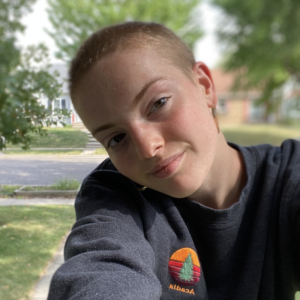On the historical neglect of the US government to human-insect symbiosis

Cockroach nymph
September 24, 2023
Bugs are friends, not foes
The relationship between humans and insects has evolved over centuries. Rather than being at the frontier of active cultivation of beneficial human-insect relations, the United States lags far behind. What first began within the USA as biological and botanical control has since evolved into a flourishing market of manufactured chemical weapons, with hundreds of millions of dollars spent on developing synthetic pesticides and insecticides.
Western monoculture farming practices have created an environment where a lack of biodiversity causes pests to thrive, in turn constructing a multimillion-dollar industry devoted to the removal and systematic killing of insects. The monopolization of pesticide corporations has resulted in a lack of agricultural innovation and the dismissal of alternative pest control opportunities.
This stagnation has led to harsher products being developed by massive pesticide corporations, crossing thresholds into deadly chemicals severely damaging ecosystems1 and human health 2, with little regard or regulations for the disastrous effects from federal governments. The American federal government paints the lack of regulations as beneficial to farmers rather than the continued dangerous exposure to harsh chemicals often resulting in various bodily failures and ailments.
With the United States government refusing to take a definitive stand on the risks of pesticides, they fail to establish a frontier that would not only protect the American people and ecosystems but provide a valuable framework for other countries to follow.
Humans are dependent on the often unnoticed work of insects. The statistic “one out of every three bites is due to a pollinator” 3 is often quoted (and rightly so, with over 70% of plant species relying on pollination 4), but pollinators also supply us with numerous other services and goods.
Pollination is not the only service insects provide. It is no exaggeration to say “insects make the world go round”. From pollination to nutrient recycling, to biological pest management, and even genetic research — without them, our ecosystem would not function.
Even the view of certain species as “pests” 5 did not begin until the mid-1600s, as the French word for disease became associated with insects in English. In other cultures across the world, insects are seen as beneficial, both as an important food source and for the essential services they provide. While research and money primarily go into supporting popular and “cute” 6 species, it is often the “creepy-crawly” ones, and those which invoke squeamish responses that contribute the most economic benefits.
Insects provide the United States with over $57 billion yearly of ecological service, in terms of dung burial, pest prevention, and pollination 7
So why is it that Western society wishes to eradicate insects? The answers are simple: negative perception of insects, the monetary impact of pesticides, and a lack of care from both the American federal government and citizens throughout the United States. Yet, the practice of eradicating insects is unique to the west.
Outside of the United States, farmers have long established and used insects as forms of biological control, dating back to 304 AD in eastern China. Hsi Han’s book “Records of the Plants and Trees of the Southern Regions”, speaks of the best method used to protect citrus trees- ants! 8 In the markets of Chiao-Chih, vendors lined the streets, many selling bags of silk, containing weaver ants. These ants lived on the citrus trees, attacking pests as they attempted to eat the sweet sap whilst protecting the mandarins that grew on the trees. This practice of biological control remained for centuries, protecting the citrus fruit of China.
America did not know of this practice until the early 20th century when a blight hit citrus trees in Florida. Hearing of the Chinese’s rumored success with citrus crops, Walter Swingle, an employee of the US Department of Agriculture and plant physiologist, was sent to inspect China’s crops 9. He was extremely surprised to see and learn of the ants, as most perceived notions in the US favored heavy chemicals. The idea of using insects to protect crops was highly controversial in the United States and has remained so, despite its great success in other countries. 10
About the author
The primary prize winner in the 2023 edition of The Harbinger Prize is a senior at Como Park Senior High in Saint Paul, Minnesota, United States.
She plans to study entomology (the science of insects) and mathematics in college and is committed to bridging the gap between scientists and farmers.

However, this new (to America) idea of using biological control to protect resources sparked curiosity from American scientists, who looked for more research opportunities. The possibility for such investigations and adaptations began at the dawn of the 20th century.
In Africa, a species of social spider (Stegodyphus mimosarum) have been encouraged to build colonies in homes, cattle barns, latrines, and public spaces for the services they provide. When American scientists first studied these spiders in the 1940s & 50s, they found that spiders ate flies that spread gastrointestinal diseases. This system of natural control worked much better than chemical control, as the flies had evolved and were no longer affected by the pesticides being used.
American scientists 11 were incredibly impressed and recommended that the Stegodyphus mimosarum be used in areas throughout the world as the spiders co-existed peacefully in the home. However, these findings were largely ignored and pushed aside in the west, as a new pesticide found acclaim — Dichlorodiphenyltrichloroethane.
As the 1940s dawned, a growing need surfaced for chemicals that would protect soldiers during World War II. Pesticides and deterrents sourced from botanicals 12 were no longer efficient enough to be used in a wide-scale event, nor was there enough to match wartime demands. Thus, the components of pesticides became completely revitalized, as the Allied Forces began to put money and emphasis on man-made pesticides, as a second development into chemical warfare. Public opinion and governmental policy began to shift from little care and insight on pesticides to full support as the United States began to fight a war on two fronts.
Dichlorodiphenyltrichloroethane (DDT) quickly became the shining star of the War World 2 pesticides and was sprayed throughout the tropics to combat malaria, typhoid fever, and a host of other diseases wiping out the Allied Forces 13. And it worked — supposedly.
The insect vectors carrying diseases died left and right. Because of DDT’s success during the war, there was a great desire for it to become publicly accessible. In 1945, it was approved for public and agricultural use in the United States, bypassing regulations from the United States Food and Drug Administration. However, the full effect of DDT had not been studied or tested. It was widely known as a cure-all — a cheap, insoluble, broad-range pesticide that had low toxicity to mammals. It was incredibly popular and, in the beginning, highly effective. Over 40,000 tons of DDT were sprayed annually, from 1945-1959 14, on crops ranging from beans to cotton, and to peanuts. DDT was also sprayed within buildings as a form of pest control.
As more and more studies were released, the side effects of the mass usage of DDT began first appearing in the 1950s, as some species of insects gained resistance to the pesticide. 15 This happens as an insect’s genes mutate, and, coupled with natural selection, leads to the high resistance of DDT in several species.
As the years passed, by the mid-1940s, over 450 species of insects and mites showed no response to DDT. To combat the rise of vector resistance, more DDT was sprayed.

A U.S. soldier is demonstrating DDT hand-spraying equipment. DDT was used to control the spread of typhus-carrying lice
Dichlorodiphenyltrichloroethane has a long-lasting effect on the environments and animals that are exposed to it. It is incredibly easy to come into contact with DDT, as DDT exposure can come from touching, consuming, or otherwise interacting with anything that was once exposed to DDT.
Long-lasting health defects also begin to occur, as DDT, along with the majority of chemical pesticides, build up in mammal tissues over exposure time. DDT has also been found in the breast milk of new mothers, thus infecting and exposing newborns. 16The effects of DDT on humans include seizures, vomiting, liver, and reproductive capability. 17
While the CDC and US health authorities now list DDT as a potential carcinogen, the American public had little knowledge of the double-edged sword of pesticide use until the early 1960s.
In 1962, Rachel Carson published Silent Spring, which brought widespread awareness to the harmful effects of DDT on mammals and the environment. She brought public attention to the loss of environmental diversity, perhaps best known for the emotional response she invoked in response to the connection between DDT and aviation death.
The impact of Silent Spring led not only to the creation of many grassroots organizations, but also the Environmental Protection Agency (EPA). 18 The establishment of the EPA came with one caveat — the head administrator, a cabinet-level position, would be chosen by the sitting president of the United States.
The EPA successfully banned the use of DDT through the 1972 Federal Environmental Pesticides Control Act 19, providing more regulations for pesticide use. During the 30 years that DDT was widely used in America, it is estimated that over 1,350,000,000 pounds of DDT were sprayed. 20
As the Americans had learned of the incredible toxicological damage that DDT caused, both the world and themselves had sprung into action to ban the usage of DDT. Culturally, pesticides became frowned upon, leading to an increase in support and demand for organic produce.
This shared perspective on pesticide use began to change with the development and rise in the popularity of GMO seed types less than a decade later. Genetically modified seeds were introduced to the market and quickly gained acclaim for their resistance to pesticides, allowing farmers and corporations to spray more chemicals and ones with higher toxicity. 21
Neonicotinoids are a new brand of pesticides being used on hundreds of millions of acres of farmland and turf across the United States. The neonicotinoid market has exploded, making over $3 billion yearly, with ‘neonics’ becoming “the most widely used insecticide in the world”. 22
As the name implies, the chemical structure of the insecticide is similar to nicotine and functions similarly. Cheap and highly effective at killing, neonicotinoids are systemic insecticides, meaning the pesticide contaminates all parts of the plant it interacts with — the leaves, roots, flowers, pollen, and nectar. 23 Neonics do not immediately kill; instead, they bind to the nerve system of the insect, cause overstimulation, and eventually rupture the insect’s nervous system. This means that whatever interacts with the plant is exposed and contaminated by neonics and that the chemical can quickly infiltrate and spread to non-target organisms.
In 2015, a sample conducted by the U.S. Geological Society found neonicotinoid pollution in 53% of water samples collected nationwide.
Deaths of bees, freshwater invertebrates 24, slugs, earthworms- even microbes in the soil- have been linked to neonicotinoid exposure. If neonicotinoid exposure does not immediately kill that which interacts with it, long-term exposure causes a decrease in health, loss of reproduction, disruption to flight ability, insufficiency of learning and memory skills, and overall collapses of social hives and colonies. 25
For these reasons, many scientists argue that neonics are over a thousand times more deadly than the chemical DDT. The effects of unchecked neonicotinoid use are becoming increasingly more apparent. Published in 2016, a German study conducted in nature reserves over a period of 27 years found a decline of 75% in insect biomass 26 — a trend that is seen reflected across the globe. The largest link to this decline in the United States is the role of pesticides in the American agricultural systems. As the bee (and other pollinating insects, including flies and wasps) species decline, money and research have gone into alternative pollination studies. Numerous studies have found that hand pollination is not nearly as effective as insect pollination 27, and although less research has gone into the other functions of insect species, the same results are shown.
It should come as no surprise that our livelihood is directly intertwined with the success and survival of insects, yet administrative policy does not reflect that. Ordinances and regulations that could protect insect life, and hence, both human assets and the global ecosystem, are lacking and insufficient in the United States.
Neonicotinoids do not only harm organisms in the wild- recently, they have also begun to appear in honey that is sold commercially. 28 The CDC published a study in 2016, discovering that, on average, half of US citizens are exposed to neonics daily. 29 Recent studies also point to a correlation between neonicotinoid exposure and breast cancer. With the surmounting research and evidence showing the impact of neonics, these synthetic pesticides have been banned across the European Union and Canada, yet not in the United States.
The US government continues to show disregard for the dangers of unchecked pesticide use, in line with pesticide companies who dispute studies pointing to the side effects of pesticide use, arguing that there is no specific correlation despite the evidence continuing to pile up. During the Trump Administration, the EPA chose to overlook scientific evidence showing the effects of chlorpyrifos (a synthetic herbicide) that, when people are exposed to it, causes nerve gas-like symptoms and developmental defects in fetuses. 30 Perhaps that is to be expected, given the United States’ history with past use of pesticides and the continued profit it brings.
The rise of new pesticides has brought with it the conglomeration of pesticide companies. Together BASF, Bayer, Dow Chemical, DuPont, Monsanto, and Syngenta control the majority of agricultural chemical and seed sales worldwide. Despite concerns from the United States and European Union, 31 mergers were proposed and passed in 2017 and 2018. 32 Referred to as the “big six”, these companies set, and inflate at will, the prices of genetically modified seeds, and “crop-protection products”. This hold over farmers has created a forced brand loyalty for many farms through programs designed to limit access to generic products at lower prices.
The Trump Administration, as well as many before it, broadcasted the ideology of “supporting farmers.” However, given the Trump administration’s upheaval of pesticide regulations, 33 despite the known serious health effects, as well as the destruction of ecosystems that synthetic pesticides cause, it seems questionable to say that loose rules for pesticide manufacturers and buyers are truly designed to benefit the working class. Pesticide regulations have become polarized — thus being seen as a political issue versus a nationwide issue affecting the health and safety of civilians across the world.
While pesticide regulations continue to be loosened and changed with every presidential term in the United States, coupled with the choice by various governments to disregard science for profit, we continue to endanger our environment and ourselves.
Biological control continues to be implemented outside of the United States 34 with successful results. Instead of mirroring this, the US upholds traditional pest management systems, limiting the possibility of a new frontier for agricultural innovation. Combined with a system of industrial farming, this “pest control” leads to a rise of resistant pests while killing insects that are beneficial to agriculture, resulting in a loss of biodiversity and natural protection for crops.
Whilst citizens continue to learn of this and push for stricter limits, the Federal Government continues to limit environmental regulations and protections while receiving donations from pesticide companies. This dangerous way of approaching environmental regulations is a warning sign. As the world continues to suffer from the worsening effects of climate change, we must reimagine our relationships with insects on a fundamental level or risk the destruction of the earth as we know it.


